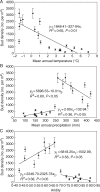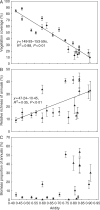Differences in below-ground bud bank density and composition along a climatic gradient in the temperate steppe of northern China
- PMID: 28633337
- PMCID: PMC5691867
- DOI: 10.1093/aob/mcx072
Differences in below-ground bud bank density and composition along a climatic gradient in the temperate steppe of northern China
Abstract
Background and aims: Understanding the changes in below-ground bud bank density and composition along a climatic gradient is essential for the exploration of species distribution pattern and vegetation composition in response to climatic changes. Nevertheless, investigations on bud banks along climatic gradients are still scarce. The below-ground bud bank is expected to be reduced in size in arid conditions, and costly, bud-bearing organs with long spacers would be replaced by more compact forms with buds that are better protected than those found in moist conditions.
Methods: How total bud density and composition (different bud bank types) change with aridity (calculated value 0·43-0·91), mean annual precipitation (MAP; 93-420 mm) and mean annual temperature (MAT; -1·51 to 6·93 °C) was tested at 21 sites along a 2500-km climatic gradient in the temperate steppe of northern China.
Conclusions: Belowground bud bank density decreases towards the dry, hot end of the climatic gradient. Based on the distribution of bud types along the climatic gradient, bulb buds and tiller buds of tussock grasses seem to be more resistant to environmental stress than rhizome buds. The dominance of annual species and smaller bud banks in arid region implies that plant reproductive strategies and vegetation composition will be shifted in scenarios of increased drought under future climate change.
Keywords: Adaptive strategy; aridification; climate change; clonal traits; community dynamics; precipitation gradient.
© The Author 2017. Published by Oxford University Press on behalf of the Annals of Botany Company. All rights reserved. For Permissions, please email: journals.permissions@oup.com
Figures






Similar articles
-
Response of under-ground bud bank to degradation in an alpine meadows on the Qinghai-Tibet Plateau, China.Front Plant Sci. 2022 Nov 1;13:1013331. doi: 10.3389/fpls.2022.1013331. eCollection 2022. Front Plant Sci. 2022. PMID: 36388515 Free PMC article.
-
Effect of the population density on belowground bud bank of a rhizomatous clonal plant Leymus secalinus in Mu Us sandy land.J Plant Res. 2019 Jan;132(1):69-80. doi: 10.1007/s10265-018-01080-9. Epub 2019 Jan 4. J Plant Res. 2019. PMID: 30610496
-
Grazing exclusion promotes grasses functional group dominance via increasing of bud banks in steppe community.J Environ Manage. 2019 Dec 1;251:109589. doi: 10.1016/j.jenvman.2019.109589. Epub 2019 Sep 20. J Environ Manage. 2019. PMID: 31546141
-
The ecology and significance of below-ground bud banks in plants.Ann Bot. 2019 Jul 8;123(7):1099-1118. doi: 10.1093/aob/mcz051. Ann Bot. 2019. PMID: 31167028 Free PMC article. Review.
-
Nitrogen addition and drought impose divergent effects on belowground bud banks of grassland community: a meta-analysis.Front Plant Sci. 2025 Jan 6;15:1464973. doi: 10.3389/fpls.2024.1464973. eCollection 2024. Front Plant Sci. 2025. PMID: 39834706 Free PMC article.
Cited by
-
Belowground seed and bud banks play complementary roles in the potential recruitment of dominant macrophyte communities in a Yangtze River-connected floodplain wetland.Front Plant Sci. 2022 Dec 6;13:1075496. doi: 10.3389/fpls.2022.1075496. eCollection 2022. Front Plant Sci. 2022. PMID: 36561449 Free PMC article.
-
Belowground bud banks and land use change: roles of vegetation and soil properties in mediating the composition of bud banks in different ecosystems.Front Plant Sci. 2024 Jan 5;14:1330664. doi: 10.3389/fpls.2023.1330664. eCollection 2023. Front Plant Sci. 2024. PMID: 38250452 Free PMC article.
-
Response of under-ground bud bank to degradation in an alpine meadows on the Qinghai-Tibet Plateau, China.Front Plant Sci. 2022 Nov 1;13:1013331. doi: 10.3389/fpls.2022.1013331. eCollection 2022. Front Plant Sci. 2022. PMID: 36388515 Free PMC article.
-
Effect of the population density on belowground bud bank of a rhizomatous clonal plant Leymus secalinus in Mu Us sandy land.J Plant Res. 2019 Jan;132(1):69-80. doi: 10.1007/s10265-018-01080-9. Epub 2019 Jan 4. J Plant Res. 2019. PMID: 30610496
-
Clonal growth characteristics and diversity patterns of different Clintonia udensis (Liliaceae) diploid and tetraploid cytotypes in the Hualongshan Mountains.Sci Rep. 2024 Jul 5;14(1):15509. doi: 10.1038/s41598-024-66067-0. Sci Rep. 2024. PMID: 38969683 Free PMC article.
References
-
- Benson EJ, Hartnett DC.. 2006. The role of seed and vegetative reproduction in plant recruitment and demography in tallgrass prairie. Plant Ecology 187: 163–178.
-
- Benson EJ, Hartnett DC, Mann KH.. 2004. Belowground bud banks and meristem limitation in tallgrass prairie plant populations. American Journal of Botany 91: 416–421. - PubMed
-
- De Boeck HJ, Bassin S, Verlinden M, Zeiter M, Hiltbrunner E.. 2016. Simulated heat waves affected alpine grassland only in combination with drought. New Phytologist 209: 531–541. - PubMed
-
- Briske DD, Zhao M, Han G, et al.2015. Strategies to alleviate poverty and grassland degradation in Inner Mongolia: intensification vs production efficiency of livestock systems. Journal of Environmental Management 152: 177–182. - PubMed
-
- Carter DL, Vanderweide BL, Blair JM.. 2012. Drought-mediated stem and below-ground bud dynamics in restored grasslands. Applied Vegetation Science 15: 470–478.
Publication types
MeSH terms
LinkOut - more resources
Full Text Sources
Other Literature Sources
Medical

